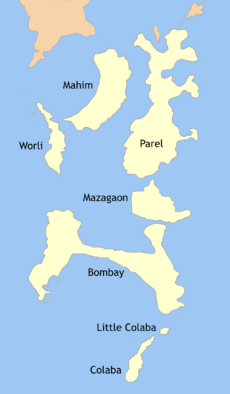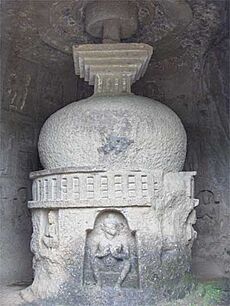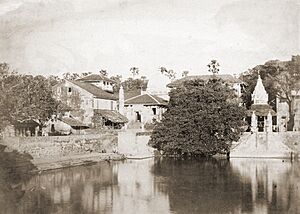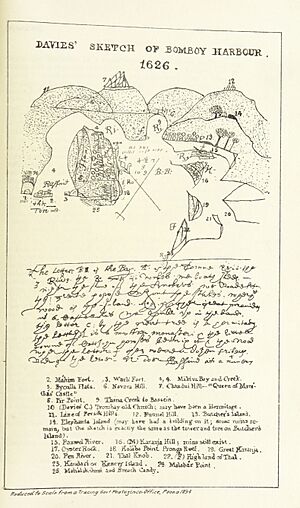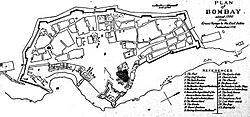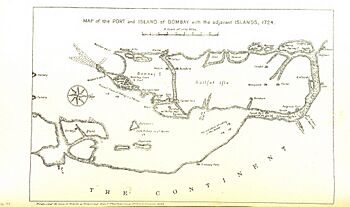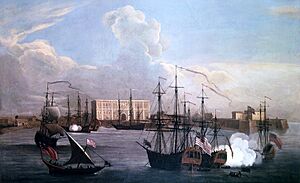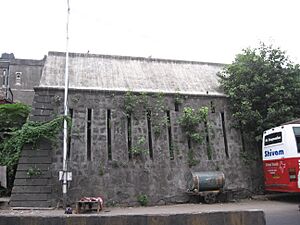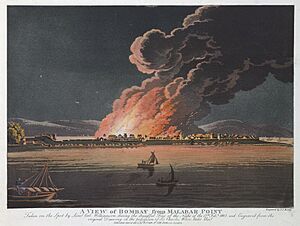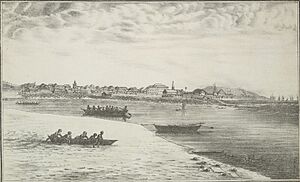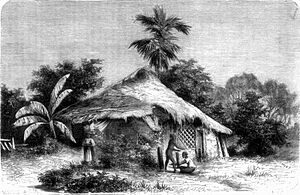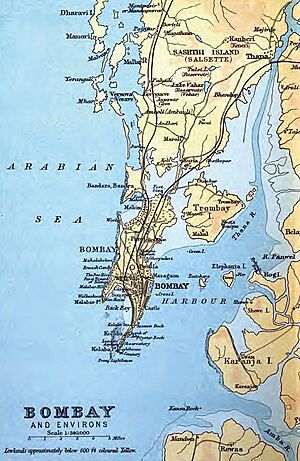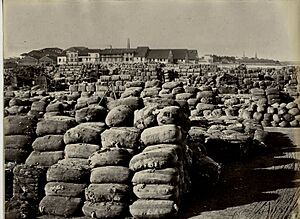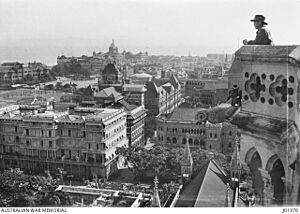History of Mumbai facts for kids
Indigenous people have lived in the area of Mumbai since the Stone Age. The Kolis and Aagri communities were the first known settlers on these islands.
Between the 2nd century BCE and the 10th century CE, different local kingdoms ruled the islands. These included the Satavahanas, Abhiras, Vakatakas, Kalachuris, Konkan Mauryas, Chalukyas, Rashtrakutas, and Silharas.
In the late 1200s, Bhima of Mahikavati started a small kingdom here and brought new settlers. The Delhi Sultanate took control of the islands in 1348. Later, in 1391, they passed to the Sultanate of Guzerat. In 1534, a treaty between the Portuguese and Bahadur Shah of Gujarat gave the islands to Portugal.
Towards the end of the 1600s, the islands faced attacks from the Marathas and Mughals. In the mid-1700s, under the English East India Company, Mumbai became an important port city. It traded with places like Mecca and Basra. The 1800s brought much economic growth. India's first railway line opened in 1853, connecting Bombay harbour and Thane. Since the early 1900s, the city has also been home to the Bollywood film industry.
Mumbai played a big role in the Indian independence movement in the early 1900s. It was central to the Rowlatt Satyagraha in 1919 and the Royal Indian Navy Mutiny in 1946. After India became independent in 1947, the area became part of Bombay State.
In 1960, after protests from the Samyukta Maharashtra Samiti movement, the city became part of the new state of Maharashtra. The Mumbai metro area later faced some unfortunate events, like the inter-communal riots of 1992–93. The 1993 Mumbai bombings also caused many deaths and much damage. Bombay was officially renamed Mumbai on March 6, 1996.
Contents
Early History of Mumbai
Ancient Times
Scientists believe that the coast of western India formed about 100 to 80 million years ago. This happened after it separated from Madagascar. Volcanic activity then created rocky hills, like Gilbert Hill, which you can still see in the city. Later, movements in the Earth's crust formed hilly islands separated by shallow seas.
Evidence found near Kandivali in northern Mumbai shows that people lived here during the Stone Age. The city we know today was built on seven original islands: Mumbai Island, Parel, Mazagaon, Mahim, Colaba, Worli, and Old Woman's Island. These islands were later joined together into one large landmass through an engineering project in 1784.
By 1000 BCE, the region was busy with sea trade with Egypt and Persia. The Kolis, a fishing community, had lived on these islands for a long time. They were among the earliest settlers.
Rule by Ancient Empires
The islands became part of the Maurya Empire in the 3rd century BCE, under Emperor Ashoka. This empire supported Buddhism, making the islands a center for Buddhist art and culture. Buddhist monks created the beautiful artwork and carvings in the Kanheri Caves and Mahakali Caves.
After the Maurya Empire declined around 185 BCE, the islands were ruled by the Satavahanas. The port of Sopara was an important trading hub in the 1st century BCE, trading with Rome. The Greek geographer Ptolemy called the islands Heptanesia, meaning "A Cluster of Seven Islands," around 150 CE.
Later, the Abhiras and Vakatakas took control. The Kalachuris ruled in the 5th century, followed by the Mauryas of Konkan in the 6th and early 7th centuries. The Jogeshwari Caves were built during their time. Christianity also arrived in the islands in the 6th century.
The Chalukyas from Karnataka took over in 610 CE. Then, the Rashtrakuta Dynasty conquered the islands around 749–750 CE.
The Silhara dynasty ruled the region from 810 to 1260. They supported the building of the Walkeshwar Temple in the 10th century and the Banganga Tank in the 12th century.
In the late 1200s, King Bhimdev started his own kingdom. He made his capital in Mahikawati (now Mahim). He brought many new people to the islands, including the Pathare Prabhus, who were among the first settlers. He also introduced many fruit trees, like coconut palms.
After King Bhimdev's death in 1303, his son Pratapbimba ruled. However, the islands were briefly taken by Mubarak Khan in 1318. Pratapbimba later won them back. In 1348, the islands came under the control of Muslim rulers from Gujarat, ending Hindu rule.
Islamic Rule
The islands were under Muslim rule from 1348 to 1391. When the Gujarat Sultanate was formed in 1391, a governor was appointed for Mahim. During the rule of Ahmad Shah I (1411–1443), the revenue system was improved.
In the early 1400s, the Bhandaris briefly took control of Mahim from the Sultanate. But it was soon recaptured. By 1429, the Gujarat Sultanate's government seat in north Konkan moved from Thane to Mahim.
The Sultanate built many mosques, including the famous Haji Ali Dargah in Mahim, built in 1431 to honor the Muslim saint Haji Ali.
In 1508, Portuguese explorer Francisco de Almeida sailed into the deep natural harbor and called it Bom baía (Good Bay). The Portuguese first visited the islands on January 21, 1509.
In 1526, the Portuguese set up their trading post at Bassein. In 1528–29, Lopo Vaz de Sampaio captured the fort of Mahim from the Gujarat Sultanate. Sultan Bahadur Shah was worried about the powerful Mughal Empire. So, he signed the Treaty of Bassein with the Portuguese on December 23, 1534. This treaty gave the islands of Mumbai and Bassein to the Portuguese. The official handover happened on October 25, 1535, ending Muslim rule in Mumbai.
Portuguese Rule
The Portuguese were very active in setting up churches and religious groups in Bombay. The islands were leased out in 1534. The San Miguel (St. Michael Church) in Mahim, one of the oldest churches in Bombay, was built by the Portuguese in 1540.
Different islands were given to various Portuguese officials. For example, Parel, Wadala, Sion, and Worli were granted between 1545 and 1548. Mazagaon was granted in 1547.
The Portuguese encouraged marriage between their people and the local population. They strongly supported the Roman Catholic Church. In 1560, they began converting local people like the Kolis and Kunbis in Mahim, Worli, and Bassein.
During this time, Bombay's main trade was coconuts and coir (coconut fiber). The St. Andrew Church at Bandra was built in 1575.
When Portugal became part of Spain in 1580, it opened the way for other European powers to come to India. The Dutch arrived first, followed closely by the British. The first English traders came to Bombay in November 1583.
The Portuguese Franciscans gained control of Salsette and Mahim by 1585. They built churches like Nossa Senhora de Bom Concelho at Sion and Nossa Senhora de Salvação at Dadar in 1596.
The Battle of Swally was fought between the British and Portuguese in 1612 for control of Bombay. Dorabji Nanabhoy, a trader, was the first Parsi to settle in Bombay in 1640. The Castella de Aguada (Fort of the Waterpoint) was built by the Portuguese at Bandra in 1640. It served as a watchtower.
By the mid-1600s, the Dutch became very powerful. This forced the British to try and get Bombay from King John IV of Portugal. In 1661, Bombay became British property as part of the dowry for the marriage of Charles II of England and Catherine of Portugal.
British Rule
Early Challenges and Growth
On March 19, 1662, Abraham Shipman was named the first Governor of the city. His ships arrived in Bombay in late 1662. However, the Portuguese Governor refused to hand over all the islands, claiming only Bombay Island was ceded. Shipman was forced to go to another island and died there.
In November 1664, Shipman's successor, Humphrey Cooke, agreed to accept Bombay without its other islands. But Cooke later managed to get Mahim, Sion, Dharavi, and Wadala for the English.
On September 21, 1668, Bombay was transferred from King Charles II to the English East India Company for a yearly rent. The Company immediately started building a quay (dock) and warehouses. They also built a customs house and strengthened Bombay Castle.
George Oxenden became the first Governor under the Company in 1668. Gerald Aungier, who became Governor in 1669, set up the first mint in Bombay in 1670. He offered business benefits that attracted many different communities, like Parsis, Goans, Jews, and Gujaratis. He also planned strong defenses for the city. The harbor was improved to hold 20 ships.
In 1670, the Parsi businessman Bhimjee Parikh brought the first printing press to Bombay. Between 1661 and 1675, the population grew six times, from 10,000 to 60,000 people.
The city faced attacks from Yakut Khan, an admiral of the Mughal Empire, in 1672 and 1689. The Dutch also attacked in 1673. However, the British resisted these attacks. In 1686, the Company moved its main base from Surat to Bombay, making it the administrative center for all their settlements in India.
By the end of the 1600s, Bombay's trade grew with many Indian ports and Arabian cities like Mecca and Basra. By 1710, Bombay Castle was finished, protecting the islands from attacks.
In 1715, Charles Boone became Governor. He continued to strengthen the island's defenses. He also established the Marine force and built the St. Thomas Cathedral in 1718, the first Anglican Church in Bombay.
A Mayor's court was set up in 1728. Shipbuilding began in Bombay in 1735, and the Naval Dockyard was established.
In 1737, the Marathas captured Salsette from the Portuguese. This forced the British to build settlements within the city's fort walls. Lovji Nusserwanjee Wadia built the Bombay Dock in 1750, the first dry dock in Asia.
By the mid-1700s, Bombay became a major trading town. Many people from different parts of India migrated to the islands. In 1769, Fort George was built. The British occupied Salsette and other nearby islands in 1774. These were formally given to the British East India Company by the Treaty of Salbai in 1782.
In 1782, Governor William Hornby started the Hornby Vellard project. This huge engineering project aimed to join the seven islands into one landmass. The goal was to stop flooding in low-lying areas. The project was completed in 1784.
Journalism in Bombay began with the Bombay Herald in 1789. In 1795, many artisans and construction workers from Andhra Pradesh moved to Bombay after the Maratha army defeated the Nizam of Hyderabad. These workers were called Kamathis.
The Sion Causeway was completed in 1802, connecting Bombay Island to Kurla in Salsette. In 1803, a large fire destroyed many parts of the Old Fort area. In 1804, a severe famine caused many people to leave Bombay.
On November 5, 1817, the British East India Company defeated the Maratha Empire in the Battle of Khadki. This victory freed Bombay from attacks by local powers.
City Development and Progress
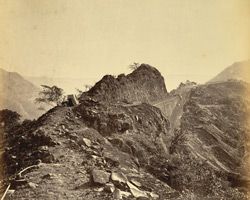
The city's education and economy grew after the British military successes. The Wellington Pier opened in 1819, and the Elphinstone High School was established in 1822.
A new road up the Bhor Ghat was opened in 1830. This road greatly helped trade between Bombay and the Deccan region. By 1830, regular communication with England began using steamers.
The Asiatic Society of Bombay (Town Hall) was finished in 1833, and Elphinstone College was built in 1835. The Chamber of Commerce was established in 1836.
In 1838, the islands of Colaba and Little Colaba were connected to Bombay by the Colaba Causeway. The Bank of Bombay, the city's oldest bank, was founded in 1840.
Avabai Jamsetjee Jeejeebhoy funded the building of the Mahim Causeway, connecting Mahim to Bandra. This work was completed in 1845. The Grant Medical College and hospital, the third in India, was founded in 1845.
The first-ever Indian railway line began operations between Bombay and Thane on April 16, 1853. The Bombay Spinning and Weaving Company, the first cotton mill, was established in 1854.
The University of Bombay was the first modern higher education institution in India, founded in 1857. The American Civil War in 1861 greatly increased the demand for cotton, leading to a huge growth in Bombay's cotton trade.
The Victoria Gardens opened in 1862. The opening of the Suez Canal in 1869 changed Bombay's sea trade. The Bombay Municipal Corporation was established in 1872, providing a modern way to govern the fast-growing city. Tramway communication started in 1873.
The Bombay Stock Exchange, Asia's oldest stock exchange, was established in 1875. Electricity arrived in Bombay in 1882, and Crawford Market was the first place to be lit by it. The Bombay Natural History Society was founded in 1883. Bombay Time, one of India's official time zones, was set in 1884. The Princess Dock was built in 1885 to improve the harbor. The Bombay Veterinary College was established in 1886.
In the late 1800s, a large textile industry grew in the city. Laws were introduced to regulate the industry, including restrictions on the working hours of children and women.
Indian Freedom Movement

Political awareness grew after the Bombay Presidency Association was formed in 1885. The first meeting of the Indian National Congress was held in Bombay from December 28–31, 1885. The Victoria Terminus, one of the world's finest railway stations, was completed in May 1888.
The idea of Dabbawalas (lunch box delivery men) started in the 1890s. British people in Bombay didn't like local food, so the Dabbawala service began to deliver home-cooked meals to their workplaces.
In August 1893, a serious riot occurred between Hindus and Muslims. In September 1896, Bombay was hit by a bubonic plague epidemic. Many people died, and about half the population fled the city. This led to the creation of the Bombay City Improvement Trust in 1898 and the Haffkine Institute in 1899.
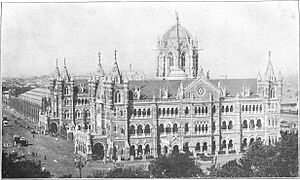
The Partition of Bengal in 1905 started the Swadeshi movement, which encouraged boycotting British goods. In 1908, Lokmanya Tilak, a leader of the Swadeshi movement, was jailed. This led to huge protests in the city. The Bombay Chronicle newspaper, started in 1910, played an important role in the independence movement.
The worldwide influenza epidemic hit Bombay from September to December 1918, causing many deaths. The first major strike in the textile industry began in January 1919. Bombay was the main center for the Rowlatt Satyagraha movement, started by Mahatma Gandhi in 1919, to protest strict British laws.
After World War I, Bombay's city life was often shut down during the Non-Cooperation Movement from 1920 to 1922. The first electric trains in India started running from Victoria Terminus to Kurla in 1925. In the late 1920s, many Persians moved to Bombay to escape drought in Iran.
In the early 1930s, the nationwide Civil disobedience movement against the British Salt tax spread to Bombay. Vile Parle was the movement's headquarters in Bombay. On October 15, 1932, industrialist and aviator J.R.D. Tata pioneered civil aviation in Bombay by flying a plane from Karachi to Bombay.
During World War II, Bombay became an important military base. The historic Quit India rebellion was announced on August 7, 1942, at a public meeting in Gowalia Tank. The Royal Indian Navy Mutiny on February 18, 1946, was a serious revolt by Indian sailors against British rule.
Finally, on August 15, 1947, India became independent. The last British troops left India through the Gateway of India in Bombay on February 28, 1948, ending 282 years of British rule.
Independent India
20th Century Events
After India's partition in 1947, over 100,000 Sindhi refugees from Pakistan were settled near Kalyan. This area became the township of Ulhasnagar in 1949.
In April 1950, the Greater Bombay District was formed by merging Bombay Suburbs and Bombay City. Its limits were expanded further in 1957.
In 1955, there were discussions about reorganizing Bombay State into Maharashtra and Gujarat based on languages. The States Reorganisation Committee suggested a bilingual state with Bombay as its capital. However, the Samyukta Maharashtra Samiti movement strongly disagreed, insisting that Bombay should be the capital of Maharashtra.
The Indian Institute of Technology Bombay was established in 1958. Following protests by the Samyukta Maharashtra movement, in which many people lost their lives, Maharashtra State was formed with Bombay as its capital on May 1, 1960. Flora Fountain was renamed Hutatma Chowk ("Martyr's Square") to honor the movement.
In the early 1960s, Parsi and Marwaris communities owned most of the industries. The Shiv Sena party was founded on June 19, 1966, by cartoonist Bal Thackeray. This party aimed to fight for the rights of native Marathi people in Maharashtra.
The Mumbai Metropolitan Region Development Authority (MMRDA) was set up in 1975 to plan development in the Mumbai metropolitan area. The Nehru Science Centre, India's largest interactive science center, was established in 1972. In 1979, a new township called Navi Mumbai was founded to help manage Mumbai's growing population.
The Great Bombay Textile Strike began on January 18, 1982, involving nearly 250,000 workers. In May 1984, riots broke out in Bombay and nearby areas, causing many deaths. The Jawaharlal Nehru Port was opened in 1989 to ease congestion at Bombay Harbour.
In December 1992 and January 1993, over 1,000 people were killed in communal riots between Hindus and Muslims. A series of 13 coordinated bomb explosions took place in Bombay on March 12, 1993, resulting in many deaths and injuries.
In 1996, the government renamed the city from Bombay to Mumbai, after the local Goddess Mumbadevi. Many colonial British names were also changed to local names, like Victoria Terminus becoming Chhatrapati Shivaji Terminus in 1996.
21st Century Events
In the 21st century, the city experienced several bombings. On December 6, 2002, a bomb exploded near Ghatkopar station, killing two people. On January 27, 2003, another bomb exploded near Vile Parle station, killing one. On March 13, 2003, a bomb in a train compartment near Mulund station killed 10 people. On July 28, 2003, a bomb on a bus in Ghatkopar killed four. On August 25, 2003, two blasts in South Mumbai near the Gateway of India and Zaveri Bazaar killed at least 44 people.
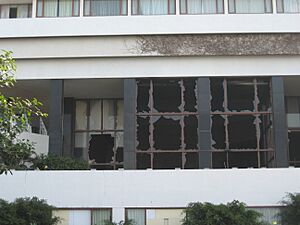
Mumbai was hit by very heavy rains on July 26–27, 2005, bringing the city to a complete stop. About 83 people died. On July 11, 2006, a series of seven bomb blasts occurred on the Suburban Railway, killing 209 people and injuring over 700.
In 2008, the city saw attacks on North Indian migrants by activists of the Maharashtra Navnirman Sena (MNS). Later that year, from November 26 to 29, 2008, there were ten coordinated terrorist attacks by armed men. These attacks resulted in 164 deaths, many injuries, and severe damage to several important buildings.
The city again experienced a series of three coordinated bomb explosions on July 13, 2011, at different locations, which left 26 people dead and 130 injured. Mumbai's Wankhede Stadium hosted the 2011 Cricket World Cup Final, where India won the championship for the second time.
See also
- Bombay Before the British
- Growth of Mumbai
- Mumbai bombings
- List of forts in Mumbai
- List of governors of Bombay Presidency
- Timeline of Mumbai events



